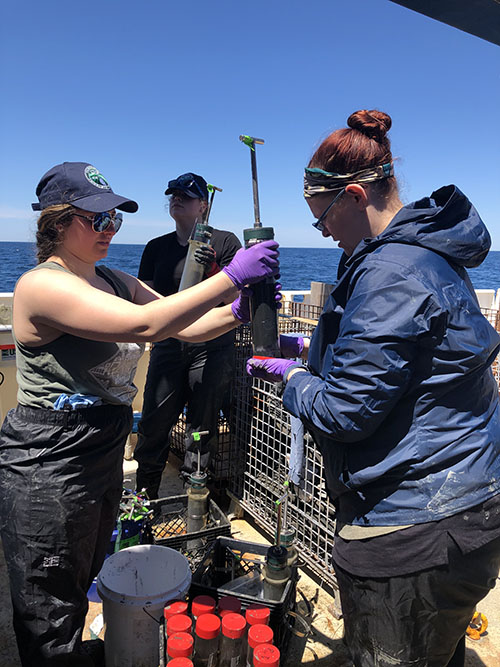
By Caitlin Adams, Operations Coordinator, NOAA Office of Ocean Exploration and Research

This overhang in Pamlico Canyon was covered in Desmophyllum dianthus cup corals. Image courtesy of Ivan Hurzeler and DEEP SEARCH 2019 - BOEM, USGS, NOAA, ROV Jason, ©Woods Hole Oceanographic Institution. Download larger version (jpg, 4.2 MB).
After spending Friday night in Morehead City, NC to avoid a storm front that affected the entire U.S. East Coast, Team DEEP SEARCH made our way back to sea to begin focused work in the canyon and seep habitats offshore North Carolina. The weather had not entirely calmed by the time we pulled away from the pier on Saturday morning, so we spent most of the day transiting to the Cape Lookout coral site and then mapping in the area, as there are significant gaps in the seafloor map there.
On Sunday morning, the seas and winds had finally settled enough for us to resume remotely operated vehicle (ROV) operations. Our first stop was Pamlico Canyon, which is about 20 miles offshore North Carolina’s Outer Banks. Submarine canyons are extreme environments in the deep sea: they can be as deep and as wide as the Grand Canyon, but they also cut deeply and narrowly into the continental shelf, acting as funnels from the shallow shelf seafloor to the plains of the deep sea. The canyon walls often have visible striations and are studded with cliffs and rocky outcroppings. Because of their unique geology, canyons also often have unique current patterns and large amounts of suspended sediments in the water column. All of this is to say: they’re not the easiest environments in which to operate an ROV. But luckily for us, we’ve got an experienced ROV team that’s always ready to face a new challenge.

This pycnogonid sea spider was seen on Dive 5 at Pamlico Canyon. Image courtesy of Ivan Hurzeler and DEEP SEARCH 2019 - BOEM, USGS, NOAA, ROV Jason, ©Woods Hole Oceanographic Institution. Download larger version (jpg, 5.5 MB).

This Acanthogorgia coral was one of our target species on Dive 5 at Pamlico Canyon. Image courtesy of Ivan Hurzeler and DEEP SEARCH 2019 - BOEM, USGS, NOAA, ROV Jason, ©Woods Hole Oceanographic Institution. Download larger version (jpg, 5.3 MB).
Our dive at Pamlico Canyon was our longest yet of this expedition, clocking in at nearly 20 hours on the seafloor. The ROV began the dive at the bottom of the canyon (nearly 1,900 meters down) and spent most of the dive slowly climbing up from there, surveying the canyon’s walls and ledges. We saw spectacular rock faces, many of which were covered in brisingid starfish, cup corals, and other deep-sea animals that get their food from particles passing by in the water. We also observed different fish species like skates and cusk eels as well as an octopus, red crabs, spider crabs, squat lobsters, and pycnogonid sea spiders. We were able to collect excellent samples of our coral target species (Acanthogorgia and Desmophyllum) as well as four sets of sediment push cores for the Demopoulos and Joye labs. By the time we recovered the ROV at 4pm on Monday afternoon, the ROV’s sample basket was completely full, and we knew we had a full night of work ahead of us!

This octopus was seen on Dive 5 at Pamlico Canyon. Image courtesy of Ivan Hurzeler and DEEP SEARCH 2019 - BOEM, USGS, NOAA, ROV Jason, ©Woods Hole Oceanographic Institution. Download larger version (jpg, 5.5 MB).
Like last year with human occupied vehicle (HOV) Alvin, the ROV recovery process is now a well-practiced ritual for Team DEEP SEARCH. Everyone who’s awake heads to the back deck once the ROV is secured onboard, and a few people head straight to the basket to begin collecting all of our samples off of it. They then pass those samples off to the rest of the team: coral quivers and biobox inserts are transported immediately to the cold room, while the push cores get carried over to the outdoor sink on the back deck. There, the mud teams remove each core from its outer housing and secure a cap on the top and bottom of each core tube before bringing them into the cold room too.

Allyson Boggess holds a push core collected from Pamlico Canyon while Jill Bourque places a rubber stopper in the bottom for safe storage before processing begins. Image courtesy of DEEP SEARCH 2019 - BOEM, USGS, NOAA. Download larger version (jpg, 4.5 MB).

Chris Kellogg and Sandra Brooke remove coral quivers from the swing arm of ROV Jason. Coral quivers are designed to hold individual samples of coral and can even be prepared to do specialized microbial sampling, as Chris has been doing on this cruise. Image courtesy of DEEP SEARCH 2019 - BOEM, USGS, NOAA. Download larger version (jpg, 5 MB).
Once all of the samples are off the ROV and appropriately stored, the real work begins—sorting and processing a basket as full as the one we collected from Pamlico Canyon can easily take another 24 hours! In our next log, I’ll tell you a little bit about what goes into all that processing, and I’ll also update you on our dive plans for the rest of the cruise.